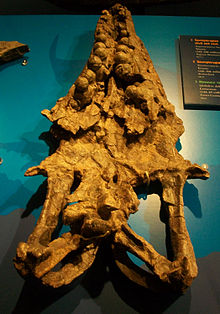Globidensini
| Globidensini | |
|---|---|

| |
| Skull of G. dakotensis (bottom view) in the Field Museum of Natural History, Chicago | |
| Scientific classification | |
| Kingdom: | Animalia |
| Phylum: | Chordata |
| Class: | Reptilia |
| Order: | Squamata |
| Superfamily: | †Mosasauroidea |
| Family: | †Mosasauridae |
| Subfamily: | †Mosasaurinae |
| Tribe: | †Globidensini |
| Genera | |
The Globidensini are a tribe of mosasaurine mosasaurs, a diverse group of Late Cretaceous marine squamates. Members of the tribe, known as "globidensins" or "globidensine mosasaurs", have been recovered from North America, Europe, Africa and Asia.[1] The tribe contains the genera Globidens (the best studied genus by far), Carinodens[2] and Igdamanosaurus.[3][4]
Towards the end of the Cretaceous, a series of adaptations allowed the highly specialized mosasaurs within the Globidensini, characterized by knob-like teeth,[5] to successfully reclaim the niche of the durophagous lifestyle. This niche had been unoccupied for most of the Mesozoic ever since the extinction of the placodonts and the durophagous ichthyosaur Grippia. The rarity of the Globidensini in the fossil record remains a mystery, perhaps it is due to habitat preference (deep water), some other form of taphonomic bias or due to the durophagous lifestyle not allowing the establishment of large populations in the first place.[6] In Angola, the dissaperence coincide with the extinction of Inoceramus shells.[7]
The robust and globular teeth have on occasion been compared to the genera Prognathodon and Plesiotylosaurus, both of which sometimes are included within the tribe. Said genera are probably not as closely connected to Globidens as such an inclusion would suggest.[8]
The etymology of the tribe derives from the genus Globidens (Latin Globus = "globe" + Latin dens = "teeth").
Description[]

Overall, globidensins were medium-sized mosasaurs, with Globidens itself reaching about 6 meters in length. The teeth of Globidens, Carinodens and Igdamanosaurus differ from those of all other mosasaurs in being very robust and globular. Most mosasaur genera have sharp teeth adapted to grab soft and slippery prey like fish and cephalopods. Though some clearly were capable of crushing through the shells of armored prey, none were as specialized as Globidens and its kin, which combined robust and powerful skulls with semispherical teeth capable of crushing through the shells of animals like ammonites, bivalves and small turtles.
Russell (1967) did not offer a proper diagnosis for the tribe when he named it, due to how poorly known the osteology of Globidens was at the time, but nevertheless erected a new tribe due to the clearly distinct features separating Globidens from the rest of the Mosasaurinae and considered Globidens to be a derived descendant of Clidastes.[9]
A more recently suggested definition is a branch-based definition diagnosing the Globidensini as the most inclusive clade containing Globidens dakotensis but not Mosasaurus hoffmannii.[8]
Jaw mechanics[]
Both the genus Globidens and Prognathodon (sometimes classified as a globidensin, though most often not) have adaptations to a powerful jaw musculature. The ratio between the length of the supratemporal fenestra and the total length of the skull has previously been used as an improvised measurement for mosasaur bite force, and is quite high in these genera (0.27 in Globidens dakotensis and 0.22 in Prognathodon overtoni and P. saturator) compared to other mosasaurs like Mosasaurus hoffmannii (with a ratio of 0.19).[6]
Species and taxonomy[]
Globidensini
- Carinodens
- C. fraasi
- C. belgicus
- Globidens
- G. alabamaensis
- G. dakotensis
- G. phosphaticus
- G. timorensis
- G. schurmanni
- Igdamanosaurus
- I. aegyptiacus
- Xenodens
- X. calminechari
References[]
- ^ "Fossilworks: Gateway to the Paleobiology Database". fossilworks.org. Retrieved 17 December 2021.
- ^ Russel, Dale (1975). "A new species of Globidens from South Dakota, and a review of globidentine mosasaurs". Fieldiana Geology. 33 (13): 235–256.
- ^ Schulp, Anne S., et al. "New mosasaur material from the Maastrichtian of Angola, with notes on the phylogeny, distribution and palaeoecology of the genus Prognathodon." On Maastricht Mosasaurs. Publicaties van het Natuurhistorisch Genootschap in Limburg 45.1 (2006): 57-67. [1]
- ^ Lindgren, Johan. "Dental and vertebral morphology of the enigmatic mosasaur Dollosaurus (Reptilia, Mosasauridae) from the lower Campanian (Upper Cretaceous) of southern Sweden." Bulletin of the Geological Society of Denmark 52.17 (2005): e25. [2]
- ^ Martin, J. E. 2007. A new species of the durophagous mosasaur, Globidens (Squamata: Mosasauridae) from the Late Cretaceous Pierre Shale Group of central South Dakota, USA. Pages 167-176 in Martin, J. E. and Parris D. C. (eds.), The Geology and Paleontology of the Late Cretaceous Marine Deposits of the Dakotas. Geological Society of America, Special Paper 427. (Globidens schurmanni)
- ^ a b Schulp, Anne S.; Jagt, John W. M.; Fonken, Frans (2004-09-10). "New material of the mosasaur Carinodens belgicus from the Upper Cretaceous of the Netherlands". Journal of Vertebrate Paleontology. 24 (3): 744–747. doi:10.1671/0272-4634(2004)024[0744:NMOTMC]2.0.CO;2. ISSN 0272-4634.
- ^ Polcyn, Michael J.; Jacobs, Louis L.; Schulp, Anne S.; Mateus, Octávio (March 2010). "The North African Mosasaur Globidens phosphaticus from the Maastrichtian of Angola". Historical Biology. 22 (1–3): 175–185. doi:10.1080/08912961003754978. ISSN 0891-2963.
- ^ a b Madzia, D., Cau, A. (2017). Inferring "weak spots" in phylogenetic trees: application to mosasauroid nomenclature Archived 2017-09-17 at the Wayback Machine. PeerJ 5:e3782
- ^ Russell, Dale. A. (6 November 1967). "Systematics and Morphology of American Mosasaurs" (PDF). Bulletin of the Peabody Museum of Natural History (Yale University). Archived from the original (PDF) on 24 June 2016. Retrieved 22 September 2017.
- Mosasaurines
- Mosasaurs of North America
- Fossil taxa described in 1912
- Mosasaurs of Asia
- Mosasaurs of Africa
- Taxa named by Charles W. Gilmore
